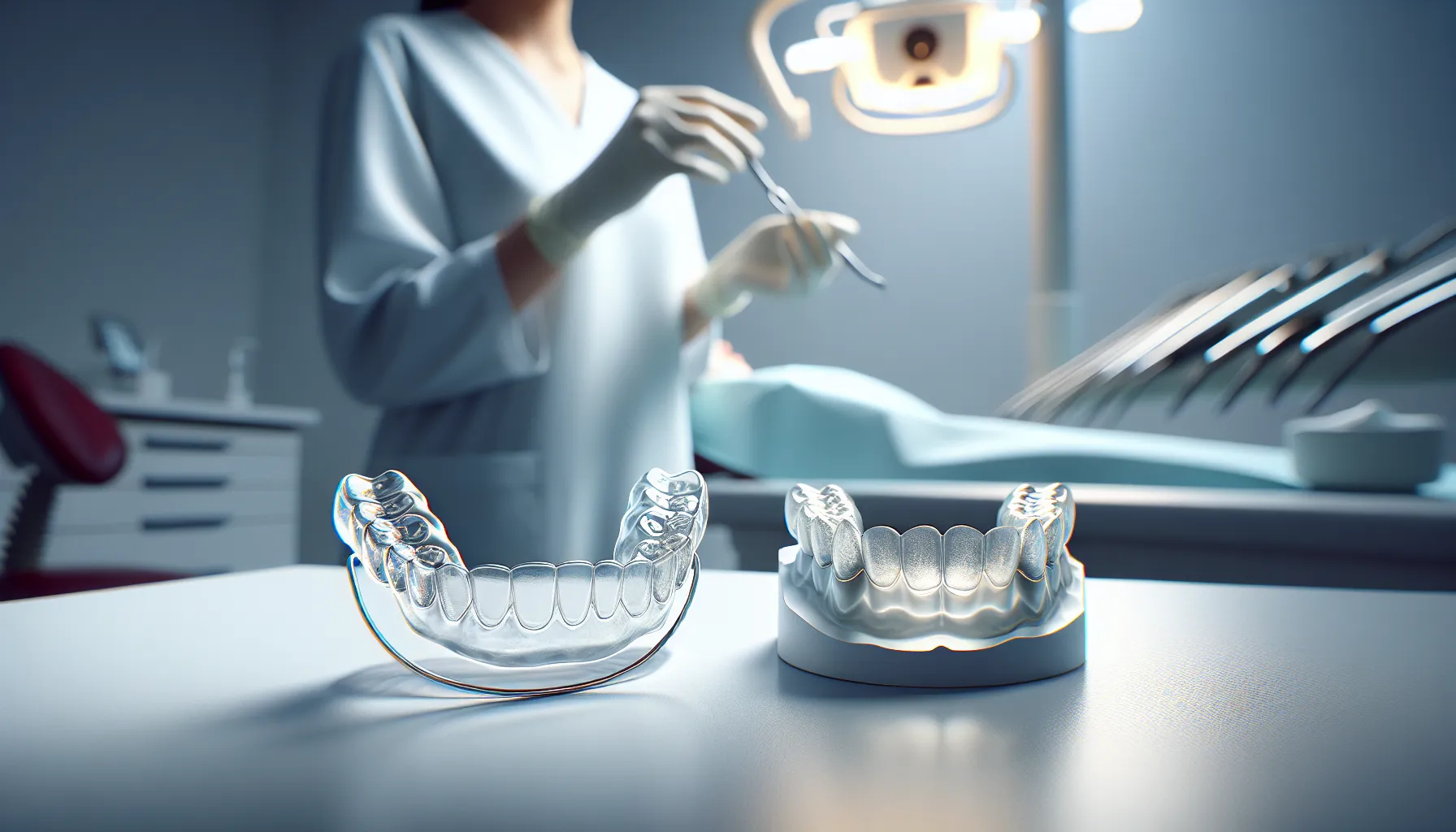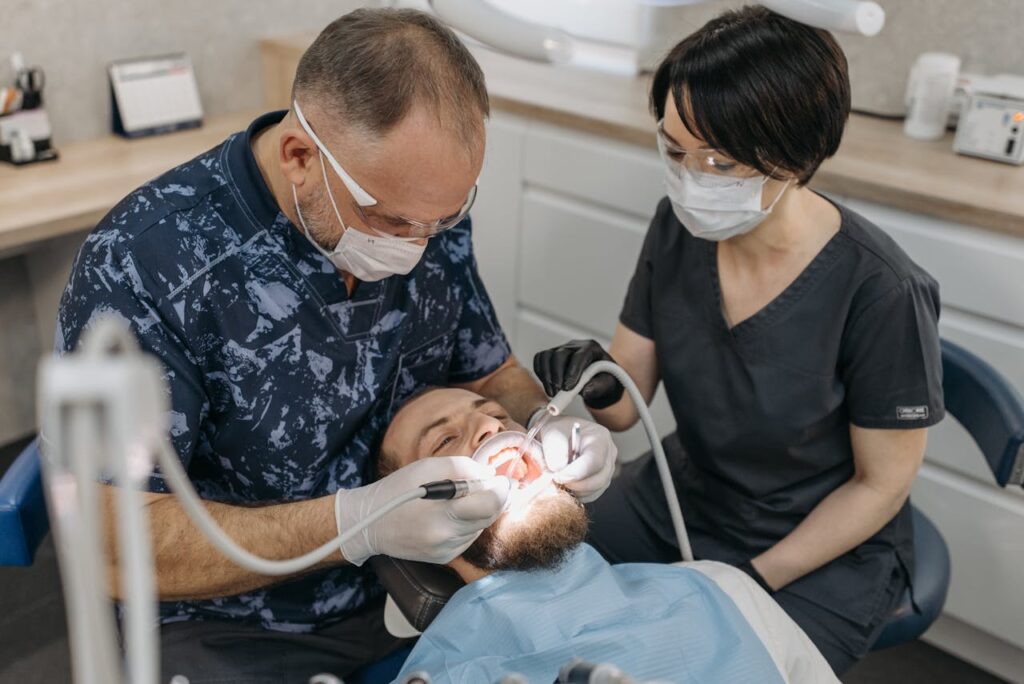Elevating healthy smiles with expert care and a gentle touch
From routine checkups to advanced treatments, we look after your whole mouth gums, teeth, jaw, and the tiny lymph and venous systems that support oral healing. With friendly faces, modern tech, and zero judgement, you’re in safe hands.


Professionals and Personalized Dental Excellence
When your smile needs thoughtful care, we’re here with clearly explained options, conservative dentistry, and comfort-first visits. Whether you’re a busy parent, a first-time patient, or coming back after a while, we tailor every plan to you.
- Personalized treatment plans
- Kid-friendly, senior-friendly
- State art imaging & sterilization
- Flexible, predictable scheduling
Complete Care for Every Smile
From routine cleanings to advanced restorations, we provide personalized dental solutions for patients of all ages.

General Dentistry
Cleanings, exams, digital X-rays, and preventive care that stop small problems before they snowball.

Cosmetic Dentistry
Whitening, bonding, veneers, and smile makeovers that look natural in person and in photos.

Pediatric Dentistry
Gentle visits that teach great habits early. Calming techniques, tiny tools, big smiles.

Restorative Dentistry
Tooth-coloured fillings, crowns, bridges, and implants built to last and feel like you.
10000+
Happy Patients
2500+
Teeth Whitened
800+
Dental Implants
15+
Years of Exeperience
Prosthodontists and Cosmetic Dentistry: Crowns, Bridges, and Dentures
You’ve probably seen those smile makeover stories on social media – the ones where someone goes from hiding their teeth to beaming with confidence. But here’s what most people don’t realize: behind many of those transformations is a dental specialist you might never have heard of. We’re talking about prosthodontists, the experts who’ve dedicated years of extra training to master the art and science of restoring smiles.
If you’re dealing with missing, damaged, or worn teeth, understanding what a prosthodontist does could change everything. These aren’t your typical dentists. After finishing dental school, they commit to three more years of intensive training focused exclusively on rebuilding and replacing teeth. That means when you sit in their chair, you’re getting someone who’s seen it all and knows exactly how to give you back your smile – and your confidence.
Here’s the thing: cosmetic dentistry isn’t just about looking good (though that’s definitely part of it). It’s about being able to eat your favorite foods without worry, speak clearly, and smile without that nagging self-consciousness. And prosthodontists? They’re the ones who make it happen through crowns, bridges, dentures, and other advanced solutions. Let’s jump into what they actually do and how they might be exactly what you need.
What Is a Prosthodontist?

Think of a prosthodontist as the architect of dental restoration. While general dentists handle your regular cleanings and basic procedures, prosthodontists are the specialists you turn to when things get complicated.
After dental school, these professionals spend three additional years in specialized residency programs. That’s three full years focusing on nothing but restorative dentistry – dental implants, crowns, bridges, dentures, aesthetics, and how your teeth fit together when you bite down. We’re not exaggerating when we say they become masters at what they do.
What sets prosthodontists apart is their expertise in diagnosis and treatment planning, especially for complex cases. Got multiple missing teeth? Severe wear from grinding? A bite that’s never felt quite right? These are the scenarios where prosthodontists shine. They don’t just fix one tooth at a time – they look at your entire oral system and figure out how to restore it properly.
We often work with patients who’ve been referred by their general dentists for cases that require specialized knowledge. And honestly, that collaborative approach benefits everyone. Your dentist knows your history, and we bring the advanced training to handle the tricky stuff. It’s teamwork at its finest, all focused on getting you the results you deserve.
The Role of Prosthodontists in Cosmetic Dentistry

Now, let’s talk about the cosmetic side of things. Because yes, we absolutely care about how your teeth look – but never at the expense of how they function.
Prosthodontists sit at this unique intersection of form and function. We perform teeth whitening to tackle discoloration that’s bothering you. We use bonding procedures to repair those annoying chips and cracks, fill gaps between teeth, or even adjust the size of teeth that seem out of proportion. But here’s where we differ from purely cosmetic providers: we’re always thinking about the long game.
Every cosmetic decision we make considers your bite, your jaw health, and how your restoration will hold up years down the road. It’s not enough for your smile to look amazing in the mirror today if it’s going to cause problems tomorrow. That’s the prosthodontic difference.
What we love most about this work is watching patients rediscover their confidence. You know that feeling when you’ve been hiding your smile for years, and suddenly you can laugh freely at dinner without covering your mouth? That’s what keeps us coming back every day. We’re restoring more than teeth – we’re giving people back a piece of themselves they thought was gone forever.
Our expertise with dental prostheses means we can handle cases that might seem impossible at first glance. Missing multiple teeth? We’ve got solutions. Severe damage from an accident? We can rebuild. The goal is always the same: help you eat comfortably, speak clearly, and smile with genuine confidence.
Dental Crowns: Restoring Function and Beauty
Crowns are one of our most versatile tools. Think of them as protective caps that slip over damaged teeth, giving them new strength and a fresh appearance.
When you come in for a crown evaluation, we start with a thorough examination and X-rays. We’re looking at the extent of damage, the tooth’s structural integrity, and how it fits into your overall bite pattern. This isn’t a one-size-fits-all situation – every crown we recommend is based on your specific needs.
When Are Crowns Recommended?
So when do you actually need a crown? Most commonly, we recommend them for teeth damaged by decay, trauma, or disease. Maybe you had a large filling that finally gave out, or you cracked a tooth biting into something hard. Perhaps you’ve got a tooth that’s been root-canaled and needs protection. These are classic crown scenarios.
What surprises people is how much a crown can do. It doesn’t just cover up the problem – it actually restores the tooth’s function. You can bite down with confidence again. The tooth is protected from further damage. And with modern materials, it looks so natural that even you might forget which tooth has the crown.
Crowns also play a role in more complex treatments. They anchor bridges, cover dental implants, and can be part of a full mouth reconstruction. Basically, they’re workhorses in the world of restorative dentistry.
Types of Dental Crowns
Here’s where it gets interesting. We work closely with skilled dental technicians to create custom crowns that fit your mouth perfectly and match your other teeth. The materials we choose depend on several factors – where the tooth is located, how much you grind your teeth, your budget, and your aesthetic goals.
Some crowns prioritize strength, others focus on appearance, and many strike a balance between the two. What matters most is that your crown fits comfortably, functions effectively, and looks natural. We take our time getting this right because a well-made crown can last for many years – sometimes decades – with proper care.
The fabrication process involves precise measurements and multiple fittings to ensure everything lines up perfectly. Your bite needs to feel right, the crown can’t irritate your gums, and it should blend seamlessly with your smile. It’s detailed work, but that attention to detail makes all the difference in your long-term satisfaction.
Dental Bridges: Filling the Gaps
Missing a tooth or two? Bridges might be your answer. These prosthetic devices literally bridge the gap where teeth used to be, anchoring to the natural teeth on either side.
How Bridges Work
The process starts with impressions. We create detailed models of your jaws and teeth to capture the exact dimensions we need. These models go to a dental laboratory where skilled technicians fabricate your custom bridge.
Once your bridge is ready, we bring you back in for fitting. This is where our training really comes into play. The bridge needs to fit snugly, match your bite perfectly, and look natural alongside your other teeth. We make adjustments as needed – sometimes several rounds of fine-tuning – until everything feels right.
What we appreciate about bridges is how they prevent the domino effect of tooth loss. When you lose a tooth, the surrounding teeth can start to shift. Your bite changes. Jaw problems can develop. A well-designed bridge stops all that before it starts, maintaining the integrity of your dental structure.
Benefits and Considerations
Bridges restore your ability to chew effectively and speak clearly. They also maintain your face shape – something people don’t think about until they see how tooth loss can age someone’s appearance.
That said, bridges do require preparing the adjacent teeth, which is something we always discuss thoroughly. You deserve to understand exactly what the process involves and what alternatives exist. Some patients prefer dental implants instead, and we’re happy to walk through those options too.
The key is finding what works for your specific situation. Your oral health, your budget, your lifestyle – it all factors into our recommendations. We’re here to guide you, not push you toward any particular treatment. After all, you’re the one who’ll be living with the results, so we want you completely comfortable with the decision.
Dentures: Complete and Partial Solutions
Let’s be real – dentures have gotten a bad rap over the years. Maybe you’ve heard horror stories about ill-fitting plates or dentures that look obviously fake. But here’s what’s changed: modern denture technology has come a long way, and prosthodontists have the specialized training to get them right.
Types of Dentures
Dentures come in two main varieties: complete and partial. Complete dentures replace all the teeth in your upper or lower jaw (or both). Partial dentures fill in gaps when you still have some natural teeth remaining.
The design process for both types requires careful planning. We’re not just replacing teeth – we’re recreating the function and appearance of your natural smile. That means considering how you speak, how you chew, how your facial muscles work, and yes, how you want to look.
Partial dentures need to work harmoniously with your remaining natural teeth. They can’t put too much pressure on certain teeth or create bite problems. Complete dentures need to fit your gums securely while looking natural and feeling comfortable. It’s a balancing act that requires both technical skill and artistic sensibility.
Modern Denture Technology
The materials we use today are light-years ahead of what was available even ten years ago. We’re talking about dentures that fit more comfortably, look incredibly natural, and restore oral function in ways that would’ve seemed impossible to previous generations.
One game-changer has been implant-supported dentures. Instead of relying solely on suction and adhesive, these dentures snap onto dental implants placed in your jawbone. The stability is remarkable. Patients tell us they forget they’re wearing dentures at all.
We also use advanced fabrication techniques that create precise fits from the start. That means fewer adjustment appointments and a smoother transition to wearing dentures. Sure, there’s still an adaptation period – your mouth needs time to get used to the new appliances – but the process is far easier than it used to be.
What we emphasize to every denture patient is that we’re partners in this process. If something doesn’t feel right, we want to know immediately. Adjustments are normal and expected. We’d rather see you three extra times to perfect the fit than have you struggling at home, too frustrated to enjoy your new smile.
Choosing the Right Prosthodontic Treatment
So how do you actually decide between crowns, bridges, dentures, or other options? That’s where our role as treatment planners becomes crucial.
We develop comprehensive treatment plans tailored specifically to you. Your individual condition matters. Your goals matter. Your preferences and concerns absolutely matter. There’s no one-size-fits-all approach in prosthodontics, and frankly, we wouldn’t want there to be.
During your consultation, we present you with customized options. For each one, we explain the advantages, the disadvantages, and any associated risks. We want you fully informed because this is your mouth, your health, and your investment. Some patients prioritize longevity and choose more permanent solutions like implants. Others need something more budget-friendly right now and opt for dentures with the plan to upgrade later. Both approaches are completely valid.
What might surprise you is how often we collaborate with other dental specialists. Need periodontal work before we can place your bridge? We’ll coordinate with a periodontist. Require orthodontic treatment as part of your smile makeover? We’ll bring an orthodontist into the conversation. This team approach ensures you get comprehensive care that addresses all aspects of your oral health.
We also consider factors you might not think about. How’s your bite? Any jaw pain or clicking? Do you grind your teeth at night? All of these elements influence which treatments will work best and last longest for you. Sometimes we discover issues that need addressing before we can move forward with cosmetic work. Better to handle those foundational problems first than build a beautiful restoration on shaky ground.
The timeline matters too. Some treatments take weeks, others take months. We’re upfront about what to expect so you can plan accordingly. And throughout the process, we’re here to answer questions, address concerns, and make adjustments as needed.
Conclusion
Here’s what we want you to take away from all this: if you’re dealing with damaged, missing, or worn teeth, you’ve got options. Real, effective options that can transform not just your smile, but your quality of life.
Prosthodontists bring specialized training and expertise to complex dental cases. We’re the ones who’ve spent extra years mastering the techniques and technologies needed to rebuild smiles. Whether you need a single crown or a complete mouth rehabilitation, we’ve got the knowledge and skills to help.
The intersection of cosmetic dentistry and functional restoration is where we do our best work. You shouldn’t have to choose between a smile that looks good and teeth that work properly. With modern prosthodontic treatment, you can have both.
So if you’ve been putting off addressing your dental concerns – maybe because you weren’t sure where to turn or what was even possible – now you know. Crowns can save damaged teeth and make them look great. Bridges can fill gaps and prevent future problems. Dentures can restore full function with comfort and aesthetics that would shock people who remember their grandparents’ dentures.
Your smile is worth the investment. More than that, your confidence, your comfort, and your ability to enjoy life without worrying about your teeth are worth it. We see the difference these treatments make in patients’ lives every single day, and honestly, it never gets old.
Ready to explore what’s possible for your smile? That’s what we’re here for. Let’s figure out together what treatment will work best for you and get you back to smiling, laughing, and living without holding back.
Routine Dental Examinations and Technology
We’ll be honest – most people don’t exactly look forward to their dental appointments. But here’s the thing: what used to be a nerve-wracking experience with bulky equipment and uncomfortable procedures has transformed into something quite different. These days, our routine dental examinations combine tried-and-true expertise with technology that makes the whole process faster, more comfortable, and way more accurate than you might remember.
If it’s been a while since your last checkup, you might be surprised at what’s changed. We’re not talking about minor tweaks here and there. The dental examination experience has evolved dramatically, and honestly? It’s made our job of keeping your smile healthy so much easier. Let’s walk through what a modern dental exam looks like and why these regular visits matter more than ever.
Why Regular Dental Examinations Matter

You know what catches us off guard? The number of patients who tell us they thought their teeth were fine, right up until something started hurting. By that point, a simple fix has often turned into something more involved.
Regular dental examinations – we’re talking every six months for most people – give us the chance to spot problems when they’re still small. That tiny cavity forming between your molars? We can address it with a simple filling during your next visit. Wait until it starts aching, and you might be looking at a root canal instead.
But it goes beyond just catching cavities. During your routine exam, we’re checking for signs of gum disease, oral cancer, grinding damage, and even health issues that show up in your mouth first. Your oral health connects to your overall health in ways that might surprise you. Periodontal disease has been linked to heart disease, diabetes complications, and respiratory problems.
Here’s what we find most compelling: early detection means less invasive treatment, less time in our chair, and frankly, less money out of your pocket. Prevention beats intervention every single time. When we catch something early, we’re often talking about a quick, straightforward fix instead of a complex procedure down the road.
And let’s not forget the peace of mind factor. There’s real value in knowing exactly where you stand with your oral health. No guessing, no worrying about what might be developing unseen. Just clear information and a solid plan to keep your smile healthy.
What to Expect During a Routine Dental Exam

Ever wonder what we’re actually doing during those appointments? Let’s break it down.
We start with your medical history – and yes, we ask every time because things change. New medications, health conditions, even supplements can affect your oral health and how we approach your care. That blood pressure medication you started last month? It might be causing the dry mouth you’ve noticed. Those details matter to us.
From there, we move into the visual inspection. We’re examining your teeth, gums, tongue, the inside of your cheeks, your throat, and even your jaw and neck area. We’re looking for anything unusual – discoloration, swelling, lesions, or early signs of oral cancer. This part of the exam takes just a few minutes, but it’s incredibly thorough.
The periodontal assessment comes next. We’re measuring the depth of the pockets between your gums and teeth, checking for bleeding, and evaluating overall gum health. Healthy gums are your teeth’s foundation, so we pay close attention here.
X-rays don’t happen at every visit – usually once a year or so, depending on your individual needs. But when we do take them, we’re looking for issues hiding beneath the surface: decay between teeth, bone loss, infections at the root, and problems with existing dental work.
We’ll also check every tooth for signs of decay and evaluate any existing fillings, crowns, or other restorations. Sometimes dental work needs updating, and catching that early prevents bigger problems.
Visual Inspection and Manual Assessment
The visual inspection might seem straightforward, but there’s a lot happening during those few minutes. We’re not just glancing around your mouth – we’re conducting a systematic evaluation of every visible surface.
Using a combination of good lighting, mirrors, and specialized tools, we examine each tooth from multiple angles. That small explorer tool we use? It helps us detect soft spots in your enamel that indicate early decay. We’re feeling for irregularities, checking the integrity of existing dental work, and assessing wear patterns that might indicate grinding or bite issues.
Your soft tissues get equal attention. The tongue, cheeks, palate, and throat can show early signs of various conditions, from vitamin deficiencies to more serious concerns. We’re trained to spot what doesn’t look right, even when it’s subtle.
The manual assessment extends to your bite and jaw function too. We observe how your teeth come together, listen for clicking or popping in your jaw joints, and check for signs of TMJ problems. These issues often develop gradually, and patients don’t always notice them until they become painful.
Professional Cleaning and Preventive Care
After the examination comes the cleaning – and this is where we remove what your toothbrush can’t.
Scaling removes tartar (hardened plaque) from your tooth surfaces and below the gumline. No matter how well you brush at home, some buildup is inevitable, especially in hard-to-reach spots. Left alone, that tartar harbors bacteria that cause gum disease and decay.
Polishing follows the scaling, smoothing your tooth surfaces and removing surface stains. It also makes your teeth feel noticeably cleaner – that’s not just psychological. Smoother surfaces are harder for plaque to stick to, so you’re starting fresh.
We finish with flossing to ensure we’ve cleared everything from between your teeth, and then comes fluoride treatment. Think of fluoride as armor for your enamel. It strengthens the outer layer of your teeth and helps reverse very early decay.
This preventive care component is just as important as the examination itself. We’re not just identifying problems – we’re actively working to prevent them.
How Technology Has Transformed Dental Examinations
If your last dental visit was more than a few years ago, you’re in for some pleasant surprises. The technology we use now has completely changed what we can see, how accurately we can diagnose, and how comfortable we can make the whole experience.
Let’s talk about what’s different.
Digital X-Rays and Imaging
Remember those uncomfortable bite-wing films that made you gag? Most of us have moved past those. Digital x-rays have replaced traditional film in most modern practices, and the difference is remarkable.
The sensors are smaller and more comfortable in your mouth. The images appear on our screen within seconds – no more waiting for films to develop. But here’s what really matters: digital x-rays use up to 90% less radiation than traditional film x-rays. The image quality is actually better too, with the ability to zoom in, adjust contrast, and enhance details that might have been missed on film.
We can also share these images with you instantly. Instead of trying to explain what we’re seeing, we pull up your x-ray right there on the screen and walk you through it. You become part of the diagnostic process, which helps you understand why we’re recommending what we’re recommending.
Some practices now use 3D cone beam imaging for more complex cases. This technology creates a three-dimensional view of your teeth, jaw, and surrounding structures. It’s invaluable for implant planning, evaluating impacted teeth, and assessing jaw problems.
Intraoral Cameras for Enhanced Visualization
This small wand-like camera might be the technology that surprises patients most. We can insert it into your mouth and capture high-resolution images of individual teeth or specific areas of concern.
What you see is what we see – in real time, magnified on a screen. That crack in your molar you couldn’t see in the mirror? Now you’re looking right at it. The worn spot on your enamel from grinding? Crystal clear.
This technology has transformed patient communication. When people can actually see what we’re talking about, they understand their dental health in a completely different way. There’s no confusion about why we’re recommending treatment – you’re looking at the same image we are.
Intraoral cameras also create a detailed visual record of your oral health over time. We can compare images from visit to visit, tracking changes and catching problems as they develop.
AI-Powered Diagnostic Tools
This is where things get really interesting. Artificial intelligence is making its way into dental diagnostics, and it’s enhancing our ability to detect problems early.
AI-powered software can analyze x-rays and identify potential cavities, bone loss, and other issues that might be easy to miss on a busy day. Think of it as a second set of expert eyes reviewing every image. The software highlights areas of concern, which we then evaluate with our clinical expertise.
Some systems can track changes in your oral health over time, flagging subtle progression that might not be obvious when comparing images side by side. Early detection of gum disease, for instance, becomes more consistent and reliable.
We’re also seeing AI tools that help predict future problems based on current conditions and trends. This shifts our approach from reactive to proactive – we’re not just treating existing issues but preventing future ones.
Benefits of Technology-Enhanced Dental Exams
So what does all this technology actually mean for you? Let’s get specific.
Improved Accuracy and Early Detection
The precision we can achieve now is honestly remarkable. Digital imaging shows us details that were invisible with older technology. We’re catching cavities when they’re barely starting, identifying hairline cracks before they turn into fractures, and spotting gum disease in its earliest stages.
Early detection changes everything. A small cavity caught early needs a tiny filling – maybe just a few minutes in the chair. Miss it for another year, and it could require a crown or root canal. The same principle applies across the board: earlier is always easier, less invasive, and less expensive to treat.
The accuracy also means fewer surprises. When we tell you something needs attention, we’re showing you exactly why, with clear visual evidence. And when we say everything looks good, you can trust that we’ve got the technology to back up that assessment.
Greater Patient Comfort and Engagement
Comfort has multiple dimensions. There’s physical comfort – digital sensors instead of uncomfortable film, faster procedures, less radiation exposure. But there’s also emotional comfort, and that’s where the visual technology really shines.
Knowing what’s happening is comforting. When we can show you images of your teeth and walk you through what we’re seeing, the mystery disappears. You understand your treatment options and can make informed decisions about your care.
Many patients tell us they feel more in control now. You’re not just sitting there hoping everything is okay – you’re actively engaged in understanding your oral health. That shift from passive to active participation reduces anxiety for a lot of people.
The technology also speeds up many procedures. Digital impressions, for instance, replace those goopy molds that made people gag. A quick scan, and we’ve got a perfect digital model of your teeth. Faster, more comfortable, more accurate.
The Future of Routine Dental Examinations
We’re excited about where dental technology is headed. What we use now is impressive, but what’s coming next? Even better.
AI will get more sophisticated, potentially identifying health issues beyond dental problems. Your mouth shows signs of systemic diseases, and advanced AI might catch early indicators of diabetes, cardiovascular issues, or autoimmune conditions during your routine exam.
We’re seeing development in non-invasive diagnostic tools that can assess tooth health without x-rays at all. Light-based technologies that can detect decay and cracks, sensors that measure gum health more precisely – these are moving from research to reality.
3D printing is already changing how we create crowns, bridges, and other dental work. In the future, we might be able to print custom treatments right in the office while you wait. What currently takes weeks could happen in a single visit.
Teledentistry expanded rapidly recently, and it’s not going away. While it won’t replace in-person examinations, it creates opportunities for follow-up care, consultations, and monitoring that make comprehensive dental care more accessible.
Virtual reality might even reduce dental anxiety. Some practices are already experimenting with VR headsets that distract patients during procedures, and the early results are promising.
The common thread? Everything is moving toward more precise, more comfortable, more personalized dental care. Your routine exam will be tailored specifically to your needs, risk factors, and health history.
Conclusion
Here’s what we want you to take away from all this: dental examinations have come a long way, and that matters for your health.
The combination of experienced clinical judgment and advanced technology means we can provide better care than ever before. We catch problems earlier, diagnose more accurately, and make the whole experience more comfortable and transparent for you.
But the technology is only as valuable as your willingness to use it. Regular dental examinations – every six months for most people – remain the foundation of good oral health. All the advanced imaging and AI in the world won’t help if you’re not coming in for checkups.
If it’s been a while since your last exam, or if you’ve been putting it off because of past uncomfortable experiences, we’d encourage you to give it another try. You might be pleasantly surprised at how much has changed. We’re not just looking at your teeth differently – we’re thinking about your overall health and wellbeing in ways that make every visit more valuable.
Your oral health connects to everything – your confidence, your nutrition, your overall health, your quality of life. Taking care of it doesn’t have to be stressful or uncomfortable anymore. Modern dental examinations are designed around you, with technology that makes the process easier, clearer, and more effective than ever before.
Schedule that checkup. Your future self will thank you.
Dental X-Rays and Radiography Imaging for Oral Health
You know that moment when your dentist casually mentions, “Let’s take a quick X-ray”? Maybe you’ve wondered what exactly they’re looking for, or if all that imaging is really necessary. We get it. Dental X-rays can feel like one of those mysterious parts of dental care that nobody really explains.
Here’s the thing: these images are doing so much more than you might realize. While we’re examining your teeth during a routine visit, there’s a whole world beneath the surface that our eyes just can’t see. Cavities hiding between teeth, infections brewing at the roots, bone loss happening silently – dental X-rays reveal what’s actually going on in there before small problems turn into painful (and expensive) ones.
We’ve seen firsthand how these diagnostic tools change everything. They help us catch issues early, plan treatments with precision, and keep your oral health on track. And with modern technology, they’re safer and faster than ever before. Let’s walk through what dental X-rays really are, why we rely on them, and what you can expect when it’s time for your next image.
What Are Dental X-Rays and How Do They Work?

Think of dental X-rays as a window into the parts of your mouth we can’t see with our eyes alone. These diagnostic images capture detailed views of your teeth, bone, and the soft tissues around your jaw. When we do a routine exam, we’re checking surfaces, gums, and visible areas. But decay between teeth? Infections at the root? Bone density changes? That’s where X-rays come in.
The process itself is pretty straightforward. X-rays use low levels of ionizing radiation – sounds scary, but stick with us – to pass through your oral tissues. The film or digital sensor placed in or near your mouth registers these rays as they travel through different structures. Dense areas like teeth and bone absorb more radiation and show up lighter on the image, while softer tissues appear darker. The result? A detailed picture that shows us exactly what’s happening beneath the gum line.
What surprises most people is just how much information we get from a single image. We can spot early-stage cavities that haven’t caused symptoms yet, identify cysts or tumors, check the positioning of incoming teeth, and assess bone health around existing teeth. Without this technology, we’d basically be flying blind, waiting for problems to become obvious – and by then, treatment gets a lot more complicated.
Types of Dental X-Rays and Radiographic Imaging

Not all dental X-rays are created equal. We use different types depending on what we’re investigating, and understanding the options helps explain why we might recommend one over another. The main categories break down into intraoral (sensor or film inside your mouth) and extraoral (imaging from outside). Each serves a specific purpose.
Intraoral X-Rays
These are the ones you’re probably most familiar with – the small sensors or film pieces we position inside your mouth. They give us incredibly detailed views of individual teeth and the surrounding bone.
Bitewing X-rays are our go-to for detecting cavities and monitoring bone density. You bite down on a small wing-shaped sensor, and we capture images of your upper and lower back teeth in one shot. They’re perfect for spotting decay between teeth (where your toothbrush can’t reach) and checking the fit of crowns or fillings. If you’ve ever wondered why we ask about cavities you didn’t know you had, bitewings are usually how we found them.
Periapical X-rays zero in on one or two teeth at a time, showing everything from the crown down to the root tip and the surrounding bone. These are essential when we suspect a root infection, abscess, or bone loss around a specific tooth. If you’re experiencing pain in one area, this is often the first image we’ll take to figure out what’s going on.
Occlusal X-rays show the full arch of your upper or lower teeth. We use these less frequently, but they’re invaluable for locating extra teeth that haven’t erupted, identifying cysts, or assessing jaw fractures after an injury. Kids often get these as we track their dental development.
Extraoral X-Rays
When we need a bigger picture – literally – we turn to extraoral imaging. These techniques capture your entire jaw, skull, or facial structures in one image.
Panoramic X-rays are the wide-angle shots of dental imaging. In a single image, we can see all your teeth, both jaws, the temporomandibular joints (TMJ), sinuses, and nasal area. They’re incredibly useful for spotting impacted wisdom teeth, planning orthodontic treatment, or looking for tumors and cysts. You’ve probably seen the machine that rotates around your head while you bite down on a plastic piece – that’s panoramic imaging.
Cephalometric X-rays focus on the side profile of your skull and show the relationship between your teeth and jaw. Orthodontists rely heavily on these for treatment planning, especially when considering braces or other alignment procedures. They help us understand your bite pattern and facial structure in ways that impact both function and aesthetics.
Why Dental X-Rays Are Essential for Oral Health
We’ll be honest: if we could reliably diagnose and treat dental problems without X-rays, we would. But the reality is that some of the most serious oral health issues develop completely out of sight. By the time they’re visible or causing pain, we’re often looking at more invasive and costly treatment. That’s where radiographic imaging becomes essential.
Early Detection of Dental Problems
This is the big one. X-rays reveal problems before they become problems, if that makes sense. Cavities forming between teeth, infections brewing at the root, bone loss from gum disease – these conditions don’t announce themselves early on. You might feel perfectly fine while decay is quietly spreading or an abscess is forming.
We’ve seen it countless times: a patient comes in for a routine cleaning with zero complaints, and a bitewing X-ray shows a cavity that’s already halfway to the nerve. Catching it at that stage means a simple filling instead of a root canal later. Same with bone loss from periodontal disease. The earlier we spot it on X-rays, the better chance we have of stopping or slowing the progression.
X-rays also help us find issues that might never be visible during an exam – like cysts, tumors, or extra teeth that haven’t erupted. These conditions can cause serious complications if left undiagnosed, but they often show no symptoms in their early stages.
Treatment Planning and Monitoring
Even when we know what needs to be done, X-rays guide how we do it. Planning for dental implants? We need detailed images of your bone structure to determine placement and whether bone grafting is necessary. Considering braces or aligners? Orthodontists use X-rays to map out tooth positioning and predict how teeth will move.
Extractions, especially for impacted wisdom teeth, require X-rays to understand the tooth’s position relative to nerves and sinuses. Root canals need images to show us the number and shape of root canals in a tooth – it varies more than you’d think. Without that roadmap, treatment becomes guesswork.
We also use X-rays to monitor treatment over time. After a root canal, we’ll take follow-up images to make sure the infection has cleared and the bone is healing. If you’re at high risk for gum disease, periodic X-rays help us track bone levels and adjust your treatment plan as needed. It’s like having checkpoints along the way to make sure we’re heading in the right direction.
Safety and Radiation Exposure Concerns
Let’s address the elephant in the room: radiation. It’s completely reasonable to wonder whether dental X-rays are safe, especially if you or your kids need them regularly. The short answer? Yes, they’re safe. But let’s talk specifics because understanding the actual risk puts things in perspective.
Modern dental X-ray systems emit incredibly low levels of radiation. We’re talking minimal exposure, especially with digital sensors, which have further reduced radiation compared to traditional film. To put it in context, the radiation from a set of bitewing X-rays is less than what you’d naturally absorb from background sources during a typical day or two. A cross-country flight exposes you to more radiation than a full-mouth X-ray series.
That said, we don’t take radiation exposure lightly. We follow the ALARA principle – As Low As Reasonably Achievable. That means using lead aprons and thyroid collars when appropriate, positioning equipment correctly, and only taking images when there’s a clear diagnostic need. We’re not snapping X-rays for fun. Every image serves a purpose.
Digital radiography has been a game-changer here. Not only do digital sensors require up to 80% less radiation than traditional film, but the images appear instantly, so there’s no need for retakes due to processing errors. We can also enhance and manipulate digital images for better diagnosis without additional exposure.
If you’re pregnant, we’re extra cautious. While dental X-rays are generally considered safe during pregnancy – especially with proper shielding – we’ll often postpone non-urgent imaging until after delivery unless there’s an acute problem that needs immediate attention.
How Often Should You Get Dental X-Rays?
This is one of those “it depends” situations, which we know can be frustrating. But the truth is, there’s no one-size-fits-all schedule. How often you need X-rays depends on your age, current oral health, risk factors, and dental history.
Healthy adults with no history of cavities or gum disease typically need bitewing X-rays every one to two years. If your check-ups consistently show no problems and you practice good oral hygiene, we can space them out. It’s really about maintaining a baseline and catching any changes early.
Children and teenagers are a different story. Their mouths are constantly changing as teeth develop and erupt, so we often recommend more frequent imaging to monitor growth patterns and catch problems early. Kids are also more prone to cavities, so bitewings might be necessary every six months to a year depending on their decay risk.
If you’re dealing with active dental disease – whether that’s cavities, gum disease, or other ongoing issues – we’ll need X-rays more frequently to monitor treatment progress and catch new problems quickly. High-risk patients benefit from closer monitoring because early intervention is key to preventing more serious complications.
New patients typically get a full set of X-rays during their first visit so we can establish a complete baseline. This gives us a comprehensive view of your oral health and helps us compare changes over time. If you’re switching dentists and have recent X-rays from your previous office, we can often request those images to avoid unnecessary duplication.
Bottom line: we’re not going to recommend X-rays unless there’s a good clinical reason. Trust that we’re balancing the diagnostic benefits against any potential risks and tailoring the schedule to your individual needs.
Digital vs. Traditional Dental Radiography
If you haven’t been to the dentist in a while, you might be surprised by how much the technology has changed. Digital X-rays have largely replaced traditional film in most practices, and for good reason. The differences go beyond just convenience.
Digital X-rays use electronic sensors instead of film. The biggest advantage? Lower radiation exposure. Digital sensors are more sensitive than film, so they require significantly less radiation to capture a clear image. We’re talking about a 60-80% reduction in exposure compared to traditional film X-rays.
The images also appear instantly on our computer screens. No waiting for film to develop in a darkroom, no chemical processing, no chance of under- or over-exposure requiring a retake. We can see the image within seconds and immediately discuss findings with you. If we need a better angle or additional views, we know right away instead of discovering it after you’ve left.
Digital images are also incredibly versatile. We can zoom in on specific areas, adjust contrast and brightness for better visualization, and even use software to highlight or measure structures. Sharing images with specialists or transferring records to a new dentist is as simple as sending an email attachment. No more waiting for film copies to be mailed or physically transported.
Traditional film X-rays aren’t bad – they’ve served dentistry well for decades. But they do require higher radiation doses, take longer to process, and involve chemical waste from development. Storage is also more cumbersome since physical films take up space and can deteriorate over time.
Some practices still use film in certain situations, and that’s okay. But if you have a choice, digital offers clear advantages in terms of safety, efficiency, and diagnostic capability. It’s one of those technological upgrades that benefits everyone involved.
What to Expect During a Dental X-Ray Procedure
If you’ve never had dental X-rays before, or if it’s been a while, knowing what to expect can ease any anxiety. The process is quick, painless, and honestly pretty straightforward. We want you to feel comfortable, so here’s the typical walk-through.
First, we’ll have you settle into the dental chair. Depending on the type of X-ray, you might stay seated or stand (panoramic X-rays typically require standing with your chin on a rest). We’ll place a lead apron over your chest and lap to shield your body from any scatter radiation. Some setups include a thyroid collar for extra protection around your neck.
For intraoral X-rays, we’ll position a small sensor or film holder inside your mouth. We’ll ask you to bite down gently or hold it in place with your finger. It might feel a bit awkward, but it shouldn’t hurt. If you have a strong gag reflex, let us know. We can adjust the positioning or use techniques to make it more comfortable. Sometimes taking slow, deep breaths through your nose helps.
Once the sensor is positioned, we’ll step out of the room or behind a protective barrier. This isn’t because X-rays are dangerous to you – remember, the exposure is minimal – but because we’re taking images all day long, and cumulative occupational exposure adds up. We’ll ask you to stay very still for just a few seconds while the image is captured. You won’t feel or hear anything. Then we’ll reposition for the next image if needed.
Panoramic and cephalometric X-rays involve standing or sitting while a machine rotates around your head. You’ll bite down on a plastic piece to keep your head steady, and the machine does the rest. The rotation takes maybe 10-15 seconds, and again, you won’t feel anything.
The whole process, even for multiple images, usually takes less than 10 minutes. Digital X-rays mean we can review the images with you right away, pointing out any areas of concern or reassuring you that everything looks good. We’ll explain what we’re seeing and answer any questions before moving on to the rest of your appointment.
If you’re anxious about radiation, uncomfortable with things in your mouth, or have any other concerns, speak up. We’ve worked with all kinds of situations and can make adjustments to help you through it. The goal is getting the diagnostic information we need while keeping you as comfortable as possible.
Conclusion
Dental X-rays might not be the most exciting part of your dental visit, but they’re absolutely one of the most valuable. They give us the insight we need to catch problems early, plan effective treatments, and monitor your oral health over time. Without them, we’d miss hidden cavities, brewing infections, and bone loss until symptoms forced your hand – and by then, treatment is almost always more involved.
The good news? Modern radiographic imaging is safer, faster, and more effective than ever before. Digital technology has slashed radiation exposure while giving us clearer, more detailed images that we can analyze instantly. We’re not taking X-rays just to check a box. Every image serves a purpose, and we’re committed to using them responsibly.
So next time we mention taking X-rays, you’ll know exactly why. We’re not just looking at what’s visible on the surface. We’re making sure everything beneath it is healthy too. That’s how we keep your smile strong for the long haul.
Trusted Dental Care for Families Near Credit Valley Hospital
🏥 A Health-Focused Community Around Credit Valley Hospital
The Credit Valley area of Mississauga has long been recognized for its focus on health and family wellness. With Credit Valley Hospital serving as a cornerstone of the community, many residents look for nearby services that support their overall well-being from fitness studios and physiotherapy clinics to trusted family dentists who understand the needs of local families.
😁 Dental Care Within Minutes of Credit Valley Hospital
Just a few minutes away from Credit Valley Hospital, Onyx Dental on Erin Centre Boulevard has become a go-to clinic for residents looking for compassionate, comprehensive dental care.
The clinic offers a full range of services including preventive cleanings, cosmetic treatments, and emergency dental care all within a welcoming, family-friendly environment.
The proximity to major routes like Eglinton Avenue West and Erin Mills Parkway makes it a convenient choice for hospital staff, patients, and local families seeking quality oral health care without the long commute across town.
🌳 A Focus on Family and Preventive Dentistry
What truly sets Onyx Dental apart is their emphasis on family-focused dentistry. The team encourages long-term preventive habits, helping both adults and children maintain strong, healthy smiles. Many local parents appreciate the gentle approach and the clinic’s commitment to patient education a small but powerful reason Onyx has earned consistent 5-star reviews across Google and other platforms.
🦷 Serving Erin Mills and Credit Valley With Modern Dental Solutions
The Erin Mills corridor continues to grow rapidly, with new families moving into the area each year. Onyx Dental’s modern approach — combining digital technology, minimally invasive procedures, and personalized treatment plans positions them as one of the most forward-thinking practices in Mississauga’s Credit Valley district.
Whether someone needs same-day crowns, teeth whitening, or restorative work after an accident, Onyx Dental provides both expertise and accessibility to the community surrounding Credit Valley Hospital.
📍 A Neighbourhood That Values Care
Residents living near Erin Mills Town Centre, Creditview Road, or Eglinton Avenue West understand how valuable it is to have reliable healthcare providers within reach. From the hospital itself to nearby wellness clinics, and trusted offices like Onyx Dental, the Credit Valley neighbourhood exemplifies what it means to build a community around health, trust, and care.
Retainers and Post Treatment Dental Care
Getting your braces off is one of those milestone moments, you’ve waited months or even years for that perfect smile, and finally, it’s here. But here’s what catches most people off guard: the work isn’t quite finished yet. That retainer your orthodontist hands you? It’s not optional, and it’s definitely not something you can ignore after a few weeks.
We’ve seen it happen more times than we can count. Someone stops wearing their retainer after a few months, thinking their teeth are “set,” only to notice shifting six months later. The frustration is real, and unfortunately, teeth don’t care how much time or money you invested in straightening them. They’ll drift back given half a chance.
The good news is that maintaining your post-treatment results doesn’t have to be complicated. With the right information about retainers and some solid habits, you can keep that smile exactly where you want it, for life.
Why Retainers Are Essential After Orthodontic Treatment

Let’s talk about why your orthodontist is so insistent about that retainer. It’s not just a precaution, it’s absolutely necessary.
When braces or aligners move your teeth into their new positions, the bone and soft tissues surrounding them need time to adapt and stabilize. Think of it like this: your teeth have lived in their original spots for years, and the supporting structures have memory. Without something holding them in place, those teeth will naturally try to return to where they came from. This backward drift is called relapse, and it happens more often than you’d think.
The reality is that teeth are never truly “locked in.” Even decades after treatment, they can shift if not properly retained. We’re talking about a lifelong commitment here, but honestly, once you get into the routine, it becomes second nature.
Here’s what most people don’t realize: the first few months after getting your braces off are the most critical. Your teeth are at their highest risk of shifting during this period because the bone around them is still remodeling. Skipping your retainer during this time, even for a few days, can lead to noticeable movement.
Retainers work by applying gentle, consistent pressure (or in the case of fixed retainers, acting as a physical barrier) that keeps your teeth exactly where your orthodontist positioned them. It’s simple physics, really. The constant presence of the retainer prevents any unwanted movement and gives your mouth time to fully adjust to its new configuration.
And let’s be honest, after investing all that time and money into orthodontic treatment, the last thing you want is to watch your teeth slowly drift back. We’ve heard too many stories of people who stopped wearing their retainers and ended up needing additional treatment years later. Don’t let that be you.
Types of Retainers and How They Work

Not all retainers are created equal, and understanding your options helps you know what to expect. Your orthodontist will recommend the type that best suits your specific situation, but it’s good to know what’s out there.
Fixed Retainers
Fixed retainers are thin wires that get bonded to the back of your teeth, usually the lower front ones, though sometimes the uppers too. You can’t see them when you smile, and honestly, after a week or two, you’ll barely notice they’re there.
The biggest advantage? You literally can’t forget to wear them. They’re working 24/7 to keep those teeth in line, which makes them incredibly effective. We particularly like them for lower front teeth because that’s where shifting tends to happen most noticeably.
The trade-off is cleaning. You’ll need to be diligent about flossing around the wire, which takes a bit more effort than regular flossing. Floss threaders or water flossers become your best friends. And yes, you’ll need to have your orthodontist check on them periodically to make sure the bond is still solid.
Removable Retainers
Removable retainers give you flexibility. You can take them out for meals, important meetings, or photos, then pop them back in afterward.
There are two main types here. Clear plastic retainers (like Essix retainers) look similar to clear aligners. They’re virtually invisible and fit snugly over your teeth. They’re comfortable and discreet, but they can crack or wear out over time, especially if you’re a nighttime grinder.
Then there are the traditional Hawley retainers, the ones with the acrylic plate and metal wire across the front. They’re more durable than the clear kind and can last for years with proper care. Sure, they’re more visible, but if you’re mainly wearing them at night, that’s not usually a concern.
The catch with any removable retainer is simple: it only works if you actually wear it. We can’t stress this enough. The most expensive, perfectly crafted retainer in the world is useless if it’s sitting in its case on your nightstand. Consistency is everything.
How Long Should You Wear Your Retainer
This is the question we hear most often, and the answer might not be what you want to hear. Ready? Indefinitely. For most people, that means nightly wear for life.
Now, let’s break that down because it’s not as intense as it sounds.
Immediately after your braces come off, you’ll typically wear your retainer full-time, and we mean all day and night, only removing it to eat and brush your teeth. This phase usually lasts anywhere from a few months to about a year, depending on your specific case and your orthodontist’s recommendation.
After that initial period, most people transition to nighttime-only wear. This is where you’re at for the long haul. Those first one to two years after treatment are absolutely crucial, your teeth and the surrounding bone are still stabilizing during this time. But even after things have settled, your teeth can still shift if given the opportunity.
Think about it this way: our bodies are constantly changing throughout our lives. Teeth naturally tend to shift forward and crowd as we age, even in people who never had braces. So if you had orthodontic treatment, you need that nightly reminder (in the form of a retainer) to keep things where they belong.
Sound like forever? Well, it kind of is. But here’s the thing, wearing a retainer while you sleep becomes as automatic as brushing your teeth. Most of our long-term patients tell us they feel weird going to bed without it. It just becomes part of the routine.
And trust us, twenty minutes of nightly wear is a whole lot easier than going through orthodontic treatment a second time.
Proper Care and Maintenance of Your Retainer
Taking care of your retainer isn’t rocket science, but there are definitely right and wrong ways to do it. Let’s make sure you’re doing it right.
Daily Cleaning Routine
Your retainer spends hours in your mouth every day, so yes, it needs regular cleaning. We’re talking daily here, not weekly, not when you remember, but every single day.
For removable retainers, the best approach is simple: rinse it every time you take it out, and give it a proper cleaning at least once a day with a soft toothbrush and mild soap. Some people use gentle dish soap, others prefer hand soap, both work fine as long as it’s non-abrasive and fragrance-free.
Here’s what you absolutely should NOT do: use hot water. Hot water can warp the plastic components of your retainer, changing its shape and making it fit improperly. Always use lukewarm or cool water. Always.
Toothpaste might seem like the obvious choice for cleaning, but many toothpastes are actually too abrasive for retainers. They can create tiny scratches where bacteria love to hide, making your retainer cloudy and less hygienic over time.
For fixed retainers, your main focus is keeping that area clean. Floss daily around the wire (yes, we know it’s tedious, but it’s necessary), and consider using a water flosser to flush out anything hiding behind the wire.
Storage and Handling Tips
This seems obvious, but you’d be shocked how many retainers end up in the trash. The culprit? Napkins.
Never, and we mean never, wrap your retainer in a napkin or paper towel. That’s a one-way ticket to the garbage can, especially if you’re eating out. Restaurant staff are not going to unwrap every napkin to check for retainers. Get yourself a retainer case (your orthodontist probably gave you one), and use it religiously.
When you’re not wearing your retainer, it should be in one of two places: in your mouth or in its case. Not on the bathroom counter. Not in your pocket. Not on your lunch tray. In. The. Case.
Keep it away from heat sources too. Don’t leave it in a hot car, near a window in direct sunlight, or anywhere else it might get warm. Remember what we said about warping? Heat is the enemy.
And please, keep it away from pets. Dogs especially seem to find retainers absolutely irresistible, and they will destroy them given the chance. We’ve heard some truly heartbreaking (and expensive) pet-chewing stories.
Common Retainer Problems and Solutions
Even with the best care, things can go wrong. Here’s what to watch for and what to do about it.
Loss or Damage: Life happens. Retainers get lost, stepped on, chewed by dogs, or accidentally thrown away. If this happens to you, call your orthodontist immediately. Don’t wait a week or two, every day without your retainer gives your teeth an opportunity to shift. Most orthodontic offices can get you a replacement relatively quickly, though there will be a cost involved (all the more reason to take good care of it).
Fit Issues: If your retainer suddenly feels tight or uncomfortable, that’s actually your teeth telling you something. Either you haven’t been wearing it consistently and your teeth have shifted slightly, or something has changed with the retainer itself.
Do not force a retainer that doesn’t fit properly. You could damage your teeth or the retainer. Instead, call your orthodontist right away. If you’ve only skipped a few days, you might be able to gradually get back into wearing it, but you need professional guidance on this. If it’s been weeks or months, you might need a new retainer altogether.
Plaque and Buildup: Notice white buildup or a cloudy film on your retainer? That’s plaque and mineral deposits from your saliva. It means your cleaning routine needs an upgrade. Plus to daily cleaning, you might need to do a deeper clean weekly with a retainer cleaning solution or a denture cleaner (just follow the package directions).
For fixed retainers, plaque buildup around the wire is your main concern. This is why those regular dental checkups and professional cleanings are so important, they’ll catch buildup you might miss.
Broken or Loose Bonds (Fixed Retainers): If you have a fixed retainer and you feel a piece of the wire coming loose or poking you, contact your orthodontist. Don’t try to fix it yourself or ignore it. A loose wire can’t do its job, and it can also irritate your tongue or gums.
Maintaining Overall Dental Health Post Treatment
Your retainer is just one piece of the post-treatment puzzle. The rest of your dental health still needs attention, maybe even more so now that your teeth are properly aligned.
Here’s something we love: straight teeth are actually easier to keep clean. When your teeth were crowded or overlapping, there were all sorts of nooks and crannies where plaque could hide. Now that everything’s lined up nicely, your toothbrush and floss can reach every surface more easily. That’s a win for cavity prevention and gum health.
But that doesn’t mean you can slack off on your oral hygiene routine. Keep brushing twice a day for two minutes each time, and yes, you still need to floss daily. With a fixed retainer, flossing becomes even more important because of that wire on the back of your teeth.
Regular dental checkups, we’re talking every six months, are non-negotiable. Your dentist will not only clean your teeth professionally but also check on how your retainer is working and whether your bite is staying stable. Think of these visits as maintenance checks for your investment.
Professional cleanings are particularly important if you have a fixed retainer. Even with excellent home care, buildup can occur around the bonded wire, and your dental hygienist has the tools to thoroughly clean that area.
Don’t forget that your newly aligned teeth can still get cavities or gum disease if you’re not taking care of them. Orthodontic treatment straightened your teeth, it didn’t make them invincible. The same good habits that kept you healthy during treatment need to continue afterward.
What to Do If You Stop Wearing Your Retainer
Let’s say you’ve fallen off the retainer wagon. Maybe you went on vacation and forgot it, or you just got busy and it’s been sitting in its case for weeks. What now?
First, don’t panic, but also don’t wait. Teeth can start shifting within days or weeks of stopping retainer wear, the exact timeline varies from person to person, but it happens faster than you’d think. The longer you wait, the more movement can occur.
If it hasn’t been too long and your retainer still fits (even if it’s a bit tight), try wearing it again. Start with shorter periods and work your way back up to your regular schedule. But, and this is important, if it feels really tight or painful, stop and call your orthodontist. You don’t want to force something that might damage your teeth.
If your retainer no longer fits at all, you’ll need to see your orthodontist for an evaluation. Depending on how much your teeth have shifted, you might need a new retainer, or in some cases, additional treatment to move things back into place before you can even wear a retainer again. We know that’s frustrating (and potentially expensive), but addressing it sooner rather than later will minimize the damage.
This is honestly one of the most preventable problems we see. We can’t emphasize enough: just keep wearing your retainer. Set a reminder on your phone if you need to. Make it part of your bedtime routine. Put the case somewhere you’ll see it. Whatever it takes.
Your future self, and your smile, will thank you.
Conclusion
We get it. After months or years of orthodontic treatment, you’re ready to be done with the appointments and the maintenance and all of it. But here’s the truth: retainers are your insurance policy on all that time, effort, and investment you just made.
The rules are pretty straightforward when you break them down. Wear your retainer as directed, full-time at first, then nightly for the long haul. Clean it daily and store it properly when it’s not in your mouth. Keep up with your regular dental checkups. And if something goes wrong, don’t wait, call your orthodontist right away.
Yes, it’s a commitment. But it’s a small one compared to what you’ve already been through. And once it becomes habit, you won’t even think about it anymore. It’ll just be what you do.
Your smile looks amazing now. Let’s keep it that way.
Educational Studies & Oral-Systemic Links: Bridging the Gap Between Mouth and Body
Educational studies in dentistry and healthcare have increasingly highlighted the intricate relationship between oral health and overall systemic health. The term “oral-systemic link” refers to the evidence showing that conditions in the mouth can significantly affect other parts of the body. Issues such as gum disease, tooth decay, and chronic oral infections are no longer seen as isolated problems but as potential contributors to cardiovascular disease, diabetes, respiratory infections, and even complications during pregnancy. By exploring these links, research emphasizes that oral health should be viewed as an essential component of general health.
The Role of Education in Raising Awareness

Educational studies play a crucial role in spreading awareness about these connections among students, professionals, and the public. In dental schools, curricula now focus on teaching future dentists how systemic illnesses can be influenced by oral conditions, equipping them to provide more comprehensive care. Public health education campaigns also highlight the importance of brushing, flossing, and routine dental visits—not only for a healthy smile but for reducing risks of more serious health conditions. These studies bridge the knowledge gap, helping people understand that oral hygiene habits directly influence long-term well-being.
Research on Chronic Diseases and Oral Health
A large portion of educational studies focuses on how chronic diseases are linked to oral health. For example, research has shown that people with periodontal disease are more likely to develop heart problems, as bacteria from the mouth can enter the bloodstream and contribute to arterial plaque formation. Similarly, diabetes and gum disease have a two-way relationship—poor oral health can worsen blood sugar control, while uncontrolled diabetes increases the risk of severe gum infections. These findings underline the importance of collaborative care between dentists and physicians, ensuring patients receive treatment that addresses both oral and systemic conditions.
Educational Interventions and Preventive Strategies
Another key theme in educational studies is the development of preventive strategies through targeted learning. Schools and universities are incorporating oral-systemic link education into health sciences, ensuring future doctors, nurses, and dentists approach patient care holistically. Preventive strategies include integrating dental screenings into general medical checkups, promoting healthier diets, and reducing smoking—all of which improve both oral and systemic health. By focusing on education-driven interventions, healthcare systems can reduce long-term costs and improve patient outcomes, creating a more sustainable approach to wellness.
Shaping the Future of Healthcare Integration
Educational studies on oral-systemic links are shaping the future of healthcare by encouraging more integrated practices. Rather than treating oral and general health separately, there is growing emphasis on collaboration across disciplines. This integration allows for early detection of diseases, better management of chronic conditions, and a stronger focus on prevention. The future points toward healthcare models where oral health professionals work hand-in-hand with medical practitioners to provide comprehensive care. By continuing to expand educational efforts, society can move closer to understanding and embracing the true impact of oral-systemic links on overall quality of life.
